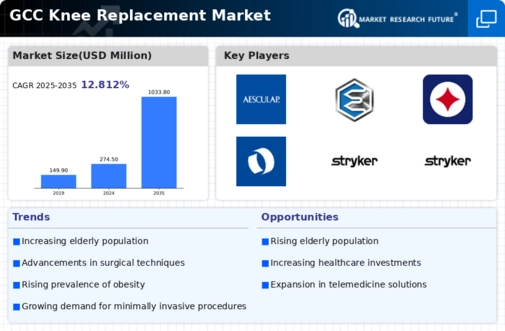Growing Awareness of Joint Health
Growing awareness of joint health and the benefits of knee replacement surgeries is a crucial driver for the market. Educational campaigns and community outreach programs in the GCC are informing the public about the importance of early intervention for joint issues. As individuals become more knowledgeable about treatment options, including knee replacements, the demand for these procedures is likely to increase. Reports suggest that patient inquiries regarding knee replacement options have surged by over 25% in recent years, indicating a shift in public perception. This growing awareness is not only encouraging patients to seek timely medical advice but also prompting healthcare providers to enhance their service offerings. Consequently, the knee replacement market is poised for growth as more individuals recognize the potential benefits of surgical intervention for improved quality of life.
Government Initiatives and Funding
Government initiatives aimed at improving healthcare infrastructure in the GCC are significantly impacting the knee replacement market. Increased funding for orthopedic services and the establishment of specialized clinics are facilitating access to knee replacement surgeries. For example, several GCC countries have launched national health programs that prioritize orthopedic care, which may lead to a projected growth rate of 8% in the knee replacement market over the next five years. Additionally, public health campaigns aimed at educating citizens about joint health and available treatments are likely to increase demand for knee replacements. This proactive approach by governments not only enhances patient access but also encourages advancements in medical technology, further stimulating the market. As a result, the knee replacement market is expected to thrive under supportive governmental policies and funding.
Advancements in Surgical Techniques
Innovations in surgical techniques and technologies are transforming the knee replacement market. Minimally invasive procedures, robotic-assisted surgeries, and improved implant designs are enhancing patient outcomes and recovery times. For instance, robotic-assisted knee surgeries have been shown to reduce hospital stays by up to 30%, which is appealing to both patients and healthcare providers. The introduction of patient-specific implants, tailored to individual anatomy, is also gaining traction, potentially increasing the success rates of surgeries. As these advancements become more widely adopted in the GCC, they are expected to drive market growth by attracting more patients seeking effective and less invasive treatment options. The knee replacement market is thus positioned to benefit from these technological improvements, which may lead to increased surgical volumes and enhanced patient satisfaction.
Increase in Sports-Related Injuries
The rise in sports-related injuries among the youth and active populations in the GCC is contributing to the demand for knee replacements. As participation in sports and physical activities increases, so does the incidence of knee injuries, which can lead to long-term joint damage. Data indicates that sports injuries account for a significant portion of orthopedic consultations, with knee injuries being among the most common. This trend suggests that a growing number of individuals may require knee replacement surgeries as a result of untreated injuries or degenerative changes. Furthermore, the increasing popularity of sports and fitness activities in the region is likely to drive the knee replacement market as more individuals seek surgical solutions to regain mobility and return to their active lifestyles. Thus, the market is expected to expand in response to this emerging health concern.
Rising Prevalence of Osteoarthritis
The increasing incidence of osteoarthritis in the GCC region is a primary driver for the knee replacement market. As populations age, the prevalence of this degenerative joint disease rises, leading to a greater demand for surgical interventions. Studies indicate that osteoarthritis affects approximately 30% of individuals over 65 years old, which is significant in the context of the GCC's aging demographic. This trend indicates that healthcare systems will need to allocate more resources to knee replacement procedures, thus expanding the market. Furthermore, the economic burden associated with osteoarthritis management, estimated at several billion $ annually, underscores the necessity for effective surgical solutions. As awareness of treatment options grows, the knee replacement market is likely to experience substantial growth in response to this rising health concern.

















Leave a Comment